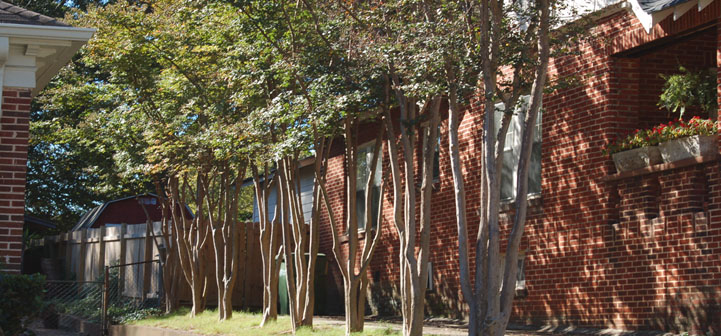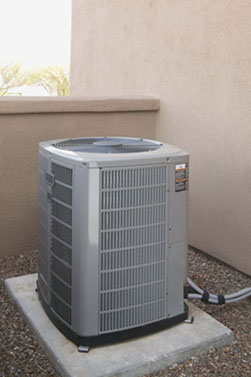Reviewed and Revised on 10/30/2013
The size, efficiency, and placement of an air conditioning (AC) system are all important factors that need to be considered when deciding on an efficient AC system in a new home.Equally critical is the air conditioning contractor selected. The operating efficiency of a system relies on proper installation to achieve its performance rating. Keys to obtaining the designed efficiency of a system in the field include: proper sizing of the system for the specific cooling load of the home; selection and proper installation of thermostats or controls; proper installation and commissioning of the system; a ductwork system designed to deliver the correct amount of conditioned air to each space within the building; and sealing and insulating all ductwork.
AC size
Sizing the air conditioner close to the actual load provides better humidity control, and typically results in energy savings when compared to an oversized air conditioner with the same performance characteristics. Better humidity control results from a higher percentage of run time during which the coil is operating at its coldest temperature (the colder you get the air, the more moisture you pull out), while energy savings result from less start and stop operation and higher comfort levels due to better humidity control. High humidity often results in lower thermostat settings. Reducing the number of cycles may also result in longer equipment life. However, close sizing also comes with requirements. Since there should not be large, excess capacity on the hottest days the system must be properly maintained—most importantly, keep it clean. Also, energy efficient features of the house that reduce air conditioning load (e.g. proper ductwork, windows, insulation, and sealing against infiltration) must actually be done and done correctly. Have the capacity and quality of the existing duct work evaluated, because the ducts may not be able to handle the added airflow for heating and cooling if a change to a heat pump is made.
Over-sizing generally results in higher equipment costs, but will allow faster pull downs, and can overcome (from a room temperature standpoint) some mistakes such as leaking ductwork, poor AC maintenance, poorly insulated ductwork, improperly installed or missing insulation, and excessive infiltration. Note that not all of these examples are due to the AC contractor.
To assure proper sizing, the load must be calculated—not just estimated based on square feet. The standard for residential air conditioning sizing is ACCA (Air Conditioning Contractors of America) Manual J, or a method based upon Manual J. Load calculations are based on the exact area, orientation, and type of construction for each component of the building envelope, as well as the heat given off by the lights, people, and equipment inside the building, etc.
Application of Manual J is generally considered to result in some over-sizing. The capacity of the unit should be its capacity at the design conditions. In general, as outdoor temperatures increase or indoor temperatures decrease, the capacity of an air-source unit decreases. Full capacity should only be needed during the hottest part of the hottest days. Variable speed units offer more flexibility than single speed units, but are more expensive and more complicated.
Energy efficiency
The cooling efficiency of a heat pump or an air conditioning system is rated by the Seasonal Energy Efficiency Ratio (SEER). The SEER is defined as a ratio of the average amount of cooling per unit of electricity used. Federal regulation mandates a minimum SEER 13.0 for most residential air conditioners manufactured after January 23, 2006. Efficiency of some systems can be as high as SEER 20 or more. Chances are that older homes have units with SEERs less than 10.
Note: SEER rating is based on equipment performance in the Virginia climate. Some equipment may not produce the listed SEER in actual operation in your climate region.
Moisture removal capacity
The Sensible Heat Ratio (SHR) describes the moisture removing capability of air conditioning systems. A SHR on Heating, Ventilation and Air Conditioning (HVAC) equipment of 0.7 means that 70% of the air conditioning load is devoted to cooling and 30% to removing humidity. It is critical that the HVAC contractor accurately estimates the humidity, or latent load. It is important to note that many high SEER units have poorer humidity removal capacity, so verify system performance before purchasing, and ask the HVAC contractor to provide written confirmation. Keep in mind that with air conditioners, which operate based on room temperature, humidity is not controlled directly, and any humidity control is a by-product of temperature control.
The importance of size, SEER, and SHR
This is where it gets a bit complex. The SEER, the SHR, and the system tonnage (a measure of the system’s size) must be in balance, so that problems don’t occur with indoor air quality. Systems without an adequate SHR, or with inaccurate tonnage, cool without removing moisture. This results in cool but “clammy” homes. Typically, when an AC system fails to provide desired levels of dehumidification, the owner response is to lower the thermostat setting. Every degree of thermostat lowering increases the cooling bills by approximately 3-5%.
An oversized air conditioner on the other hand cools a home “too” quickly and does remove the moisture very effectively
Location of different AC components
Central HVAC systems have a component called an air handling unit or AHU. The advantages of placing the AHU in a conditioned space include: it is in a more benign environment; a central location can minimize duct lengths and optimize air flow; there is easier access for maintenance; and any leaks occur in conditioned space.
An often-neglected area of AC installation concerns the placement of the outside unit (condensor). Manufacturer recommendations for proper clearance distances should be followed to ensure there is no blockage of air flow from the unit. Also, do not vent a clothes dryer within 10 feet of the outdoor unit, because dryer lint will cling to the condensing coil, lowering both the system’s efficiency and service life.
Questions the HVAC contractor should ask you
The HVAC contractor should ask you the following questions to help properly conduct a comfort analysis and system design for your family and home:
- Would you like to change anything about your current air conditioning and/or heating system?
- What do you like most about your present system?
- What benefits do you expect from your new system?
- Does your existing system heat and cool your home to your satisfaction?
- Are there rooms that are too hot or too cold?
- What temperature is your thermostat set on during the summer? Winter?
- Do you have a scheduled lifestyle that encourages adjusting the thermostat frequently, or while you’re not at home?
- Do you set the thermostat at different temperatures for the hours when you’re awake and the hours you’re asleep?
- What types of heating or cooling problems have you experienced?
- Have you had any problems with condensate drainage?
- What is your average summer electric bill?
- Who performs your regular energy-savings check-ups?
- How long do you plan on residing in this home?
- Do you plan to remodel or expand your floor plan in the future?
- Have you made any changes to your home since the existing air conditioning and/or heating system was originally installed?
- How many people reside in your home?
- Does anyone residing in your home have allergies?
- Do you understand ratings like SEER and SHR?
- Do you understand how HVAC systems work, or more specifically, do you understand how the system I’m recommending works?
You should also realize that many of the same questions should be asked when determining which HVAC system should go in a new home. In addition…
- Be sure your contractor is licensed (if required in your municipality), well trained, and experienced. Ask to see a valid license, proof of coverage for workers’ compensation, and certificate of insurance coverage for liability and property damage. Inquire about references and membership in contractor associations. Ask for proof that your contractor is certified to handle refrigerant in cooling systems.
- Request a calculation of your savings. Heating and cooling equipment comes with two price tags: the cost to buy the equipment and the cost to operate. Your contractor should be able to calculate your utility bill savings and total lifetime costs.
- Request a load calculation. Ask your contractor to calculate equipment size using computer software or professional guidelines. This will require taking measurements in your house and asking questions. Don’t use a contractor who wants to size your system solely on the square footage of your house.
- Inspect ducts. Ask your contractor to inspect your ducts for leaks, incomplete connections, and compatibility with the rest of your system. Evaluate your system’s performance. Ideally, your contractor should use diagnostic equipment, and, if necessary, fix leaks using a UL-rated quality duct sealant (not duct tape). In some cases, proper duct repairs may include actual duct modifications to ensure proper supply and return airflow.
- Consider a house pressurization test. Test your house and appliances for “backdrafting,” which occurs when the fumes from the combustion process are pulled back into the home, threatening the health and safety of occupants.
- Replace both indoor and outdoor coils. If you’re replacing an air conditioner or heat pump, be sure to replace both indoor and outdoor coils on a matched system for maximum efficiency and reliability.
- Obtain a written contract. Always obtain a written contract or proposal before allowing your contractor to install a new system. Be sure to ask about warranties for labor and parts.
- Weigh the costs. Remember that the lowest price may not always be the best price. Carefully evaluate a contractor’s proposal to ensure you get the equipment and service that best meets your needs. Paying slightly more now may get you better equipment and service, and save you money in the years to come due to lower costs of ownership.
- Install for easy maintenance. Make sure the inside coil can be reached for its annual cleaning. The air filter(s) should also be easily removed, cleaned, or changed when dirty. Check filter(s) monthly during peak season.

